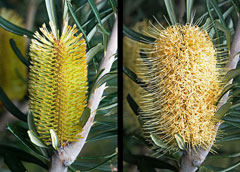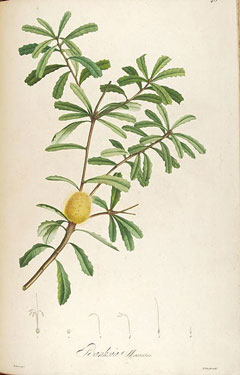 |
|
http://commons.wikimedia.org/wiki/User:Noodle_snacks |
 |
| http://commons.wikimedia.org/wiki/File:Banksia_marcescens-(marginata)_crop.jpg |
Translate this page:
Summary
Physical Characteristics

 Banksia_marginata is a TREE growing to 9 m (29ft 6in).
Banksia_marginata is a TREE growing to 9 m (29ft 6in).
See above for USDA hardiness. It is hardy to UK zone 9 and is frost tender. It is in flower from August to December. The species is hermaphrodite (has both male and female organs).
Suitable for: light (sandy) and medium (loamy) soils, prefers well-drained soil and can grow in nutritionally poor soil. Suitable pH: mildly acid and neutral soils. It cannot grow in the shade. It prefers moist soil. The plant can tolerates strong winds but not maritime exposure.
UK Hardiness Map
US Hardiness Map
Synonyms
Plant Habitats
Edible Uses
The flowers are filled with a sweet nectar which can be sucked directly or washed out with water to make a refreshing beverage[183, 193].
References More on Edible Uses
Medicinal Uses
Plants For A Future can not take any responsibility for any adverse effects from the use of plants. Always seek advice from a professional before using a plant medicinally.
None known
References More on Medicinal Uses
The Bookshop: Edible Plant Books
Our Latest books on Perennial Plants For Food Forests and Permaculture Gardens in paperback or digital formats.

Edible Tropical Plants
Food Forest Plants for Hotter Conditions: 250+ Plants For Tropical Food Forests & Permaculture Gardens.
More

Edible Temperate Plants
Plants for Your Food Forest: 500 Plants for Temperate Food Forests & Permaculture Gardens.
More

More Books
PFAF have eight books available in paperback and digital formats. Browse the shop for more information.
Shop Now
Other Uses
The bark contains 10% tannin. This species has been used as a rootstock for propagating other members of the genus. Wood - soft, easily worked, pinkish with a prominent grain. It is highly decorative but the plants tend to be gnarled and irregular thus limiting its use. Used for veneers, furniture etc.
Special Uses
References More on Other Uses
Cultivation details
Requires a well-drained lime-free soil and a sunny position[1, 200]. Thrives in acid sandy loams[167, 200]. Prefers a pH between 6.3 and 6.5[200]. Plants are tolerant of damp soils and sea winds[260]. If this species is to be successfully cultivated, the soil should be low in nutrients, especially in nitrates and phosphates[200]. This species is not very cold-hardy, possibly tolerating temperatures down to around -5°c[260]. Plants require greenhouse protection in most parts of Britain[1] but high-altitude forms could succeed outdoors in the mildest areas of the country[200]. This species hybridizes in the wild with B. integrifolia and B. conferta penicillata[200]. A good bee plant[154, 167].
References Carbon Farming Information and Carbon Sequestration Information
Temperature Converter
Type a value in the Celsius field to convert the value to Fahrenheit:
Fahrenheit:
The PFAF Bookshop
Plants For A Future have a number of books available in paperback and digital form. Book titles include Edible Plants, Edible Perennials, Edible Trees,Edible Shrubs, Woodland Gardening, and Temperate Food Forest Plants. Our new book is Food Forest Plants For Hotter Conditions (Tropical and Sub-Tropical).
Shop Now
Plant Propagation
Seed - surface sow in an ericaceous compost as soon as the seed is ripe or as soon as it is obtained and do not exclude light. Seal the pot in a plastic bag until germination takes place, which can take 1 - 3 months or more at 20°c[134]. When they are large enough to handle, prick the seedlings out into individual pots and grow them on in the greenhouse for at least their first winter. Plant them out into their permanent positions in late spring or early summer, after the last expected frosts. Cuttings of half-ripe wood, July/August in sand in a frame[200].
Other Names
If available other names are mentioned here
Native Range
AUSTRALASIA: Australia (Tasmania, New South Wales (east), South Australia (southeast), Victoria)
Weed Potential
Right plant wrong place. We are currently updating this section.
Please note that a plant may be invasive in one area but may not in your area so it’s worth checking.
Conservation Status
IUCN Red List of Threatened Plants Status :

Growth: S = slow M = medium F = fast. Soil: L = light (sandy) M = medium H = heavy (clay). pH: A = acid N = neutral B = basic (alkaline). Shade: F = full shade S = semi-shade N = no shade. Moisture: D = dry M = Moist We = wet Wa = water.
Expert comment
Author
Cav.
Botanical References
200
Links / References
For a list of references used on this page please go here
Readers comment
| Add a comment |
|
If you have important information about this plant that may help other users please add a comment or link below. Only comments or links that are felt to be directly relevant to a plant will be included. If you think a comment/link or information contained on this page is inaccurate or misleading we would welcome your feedback at [email protected]. If you have questions about a plant please use the Forum on this website as we do not have the resources to answer questions ourselves.
* Please note: the comments by website users are not necessarily those held by PFAF and may give misleading or inaccurate information.
To leave a comment please Register or login here All comments need to be approved so will not appear immediately.
|
Subject : Banksia_marginata
|
|
|
|